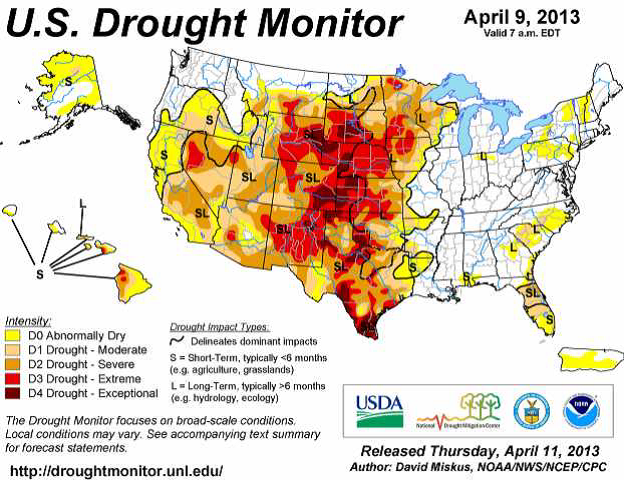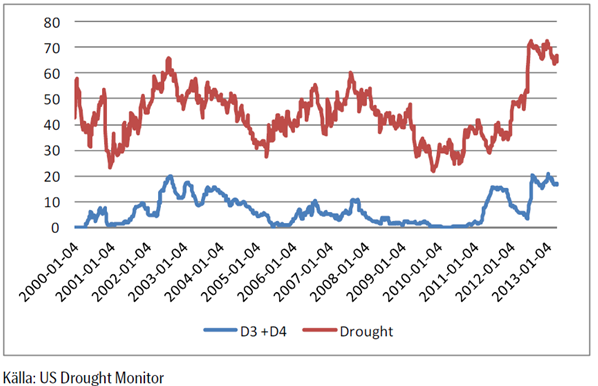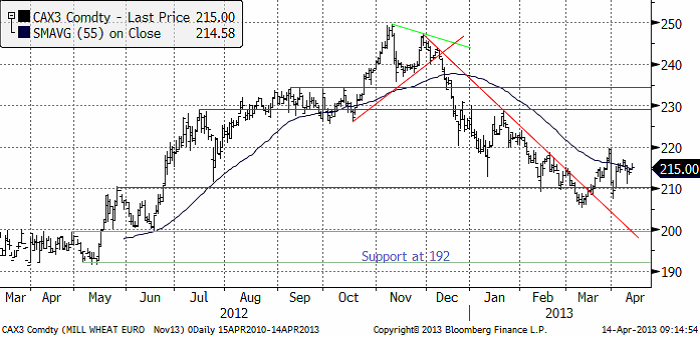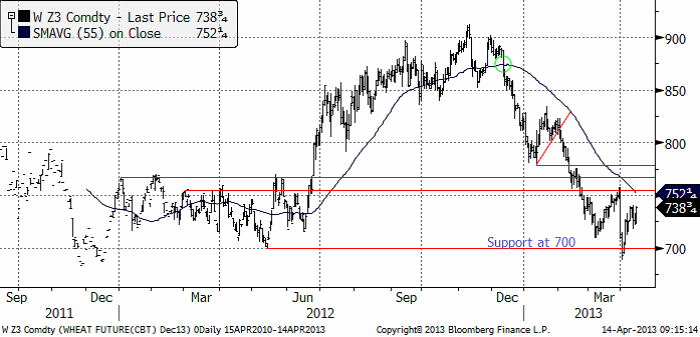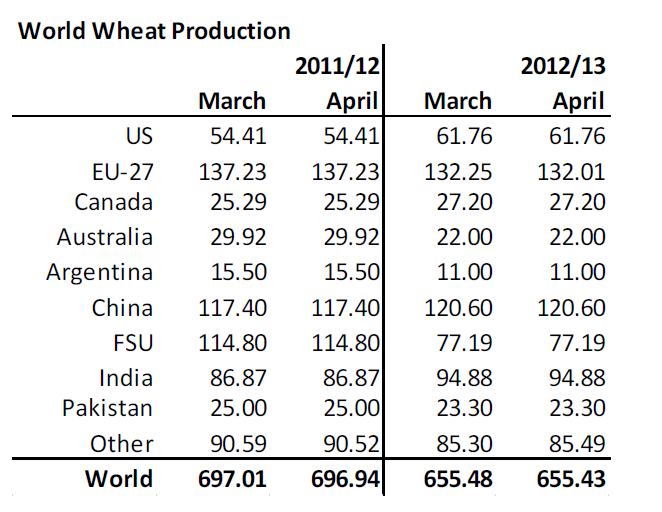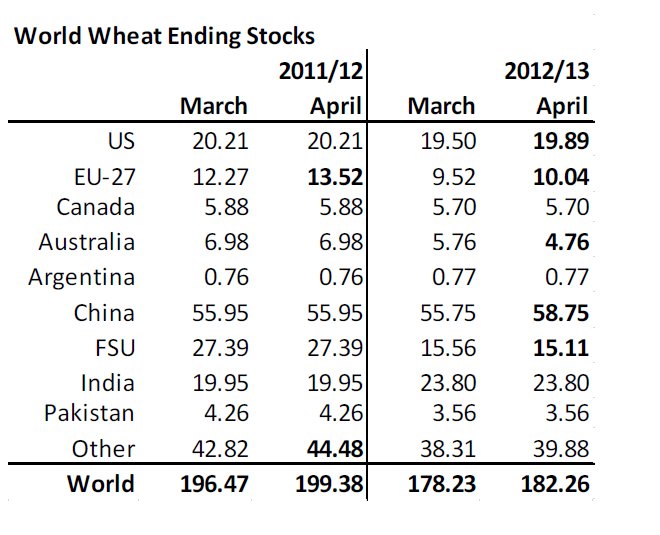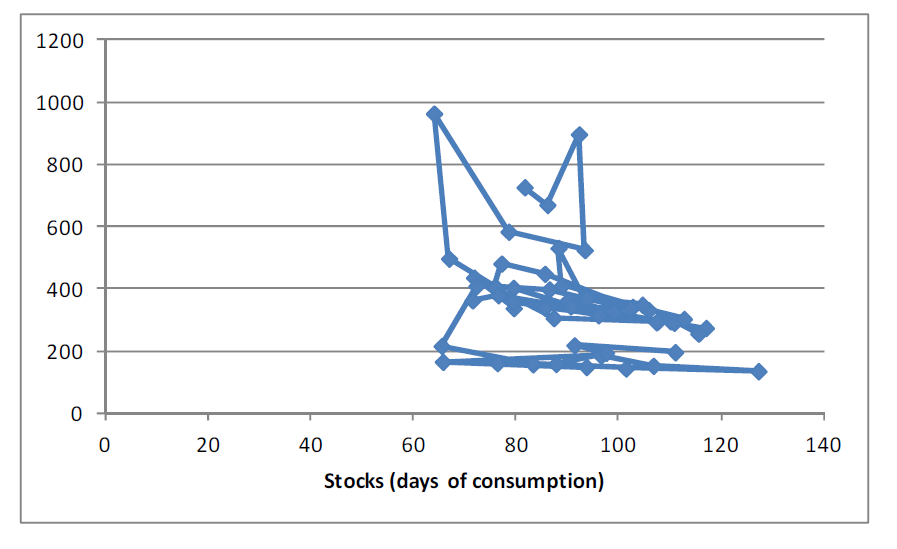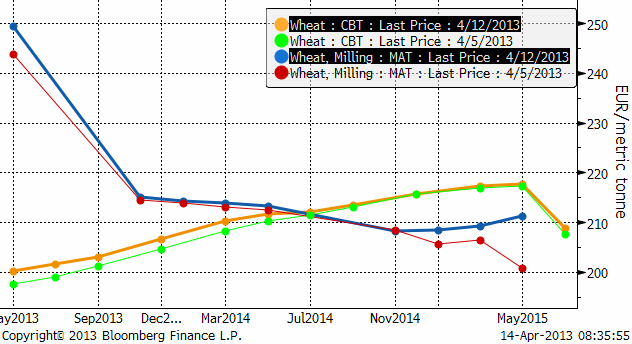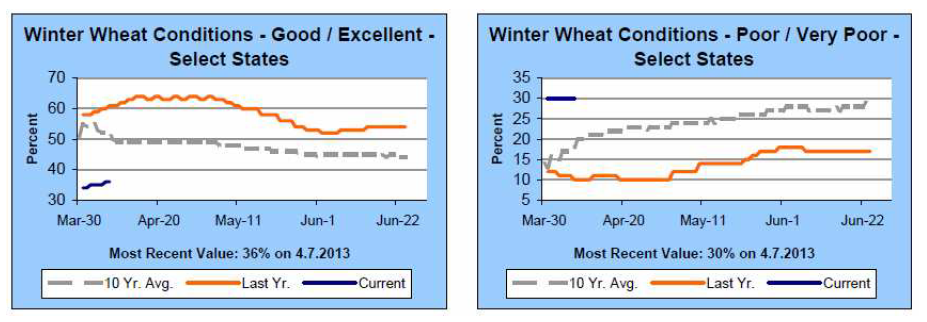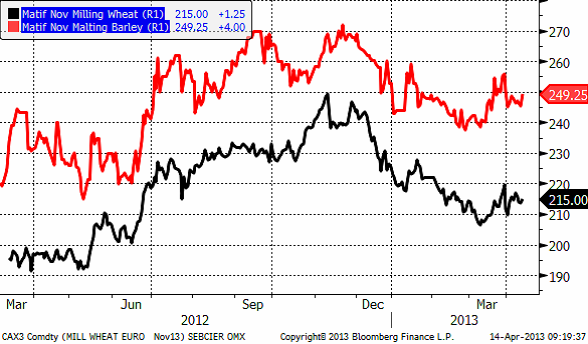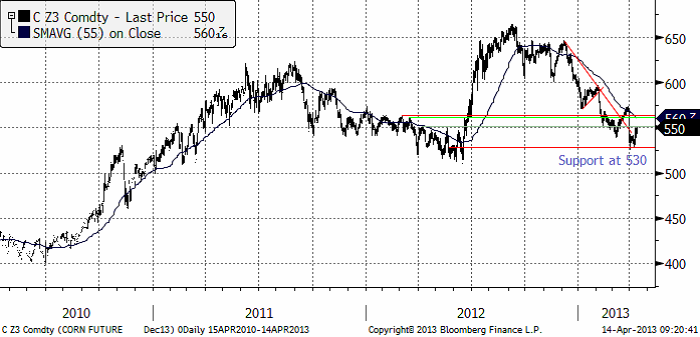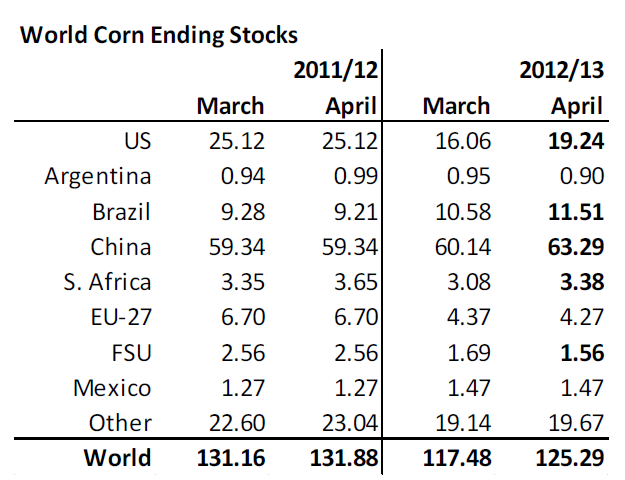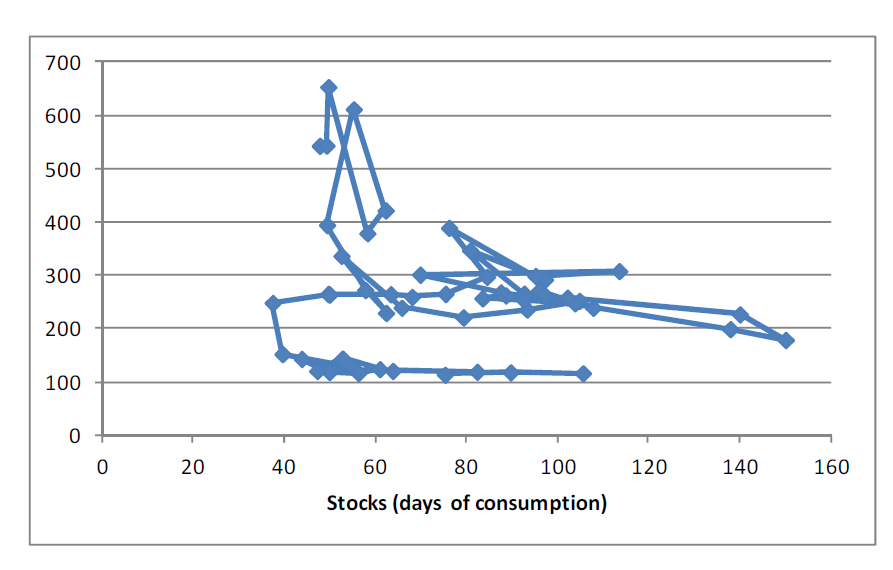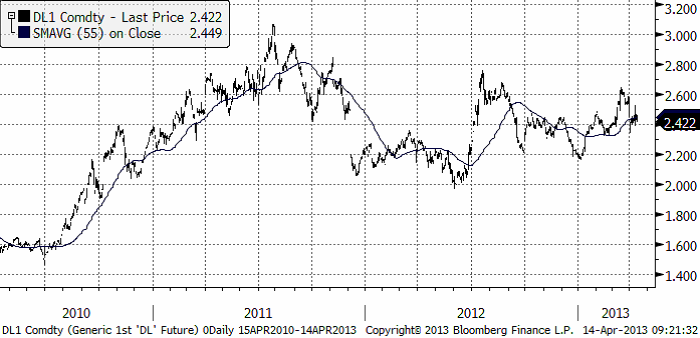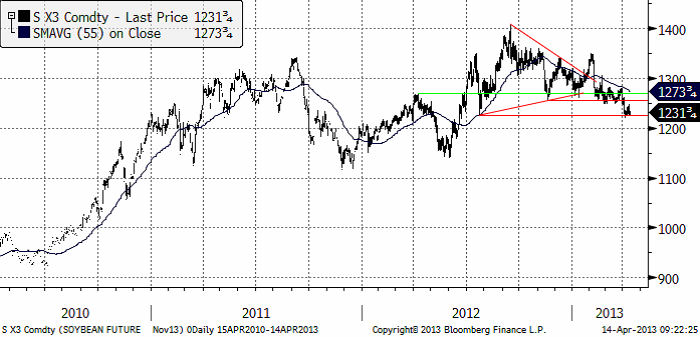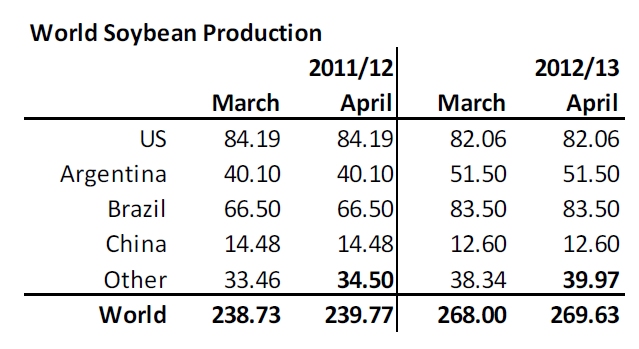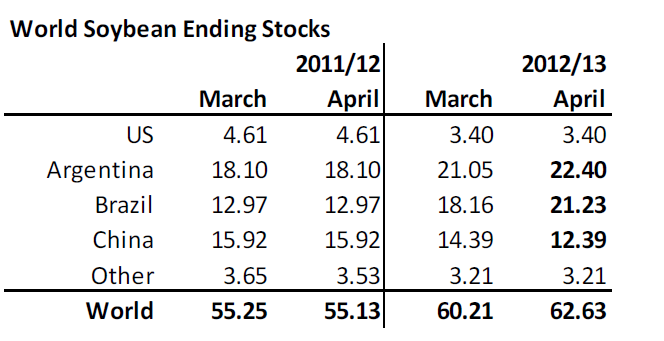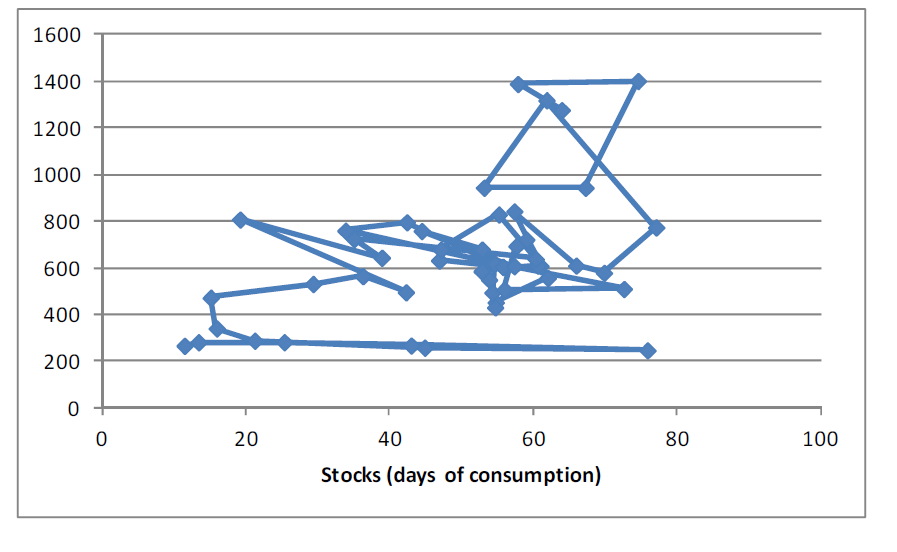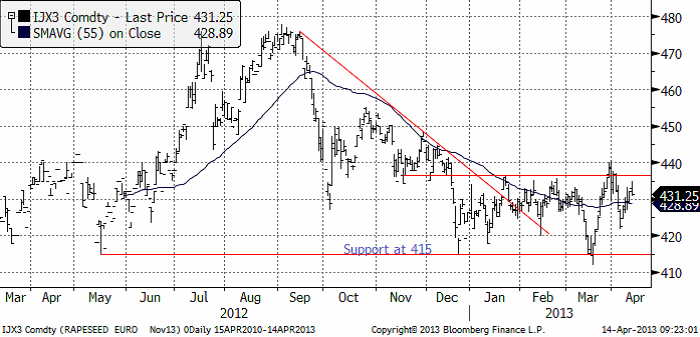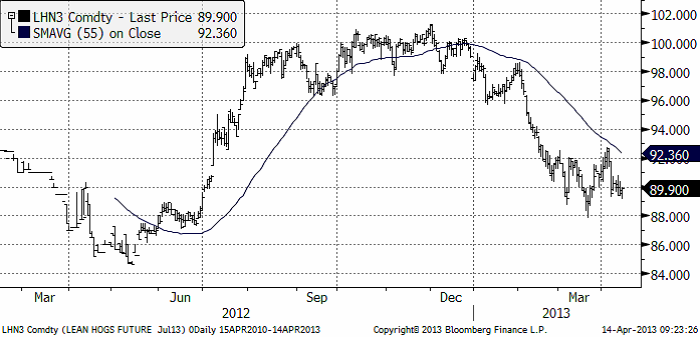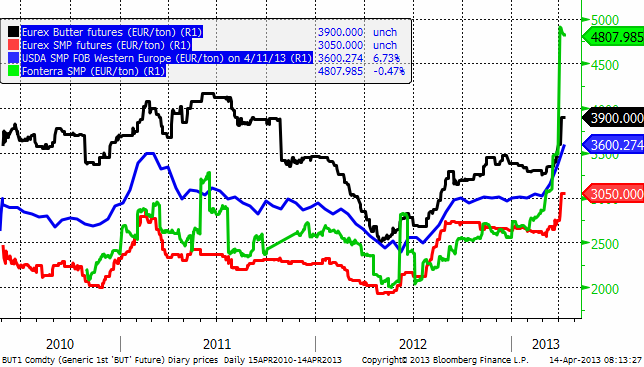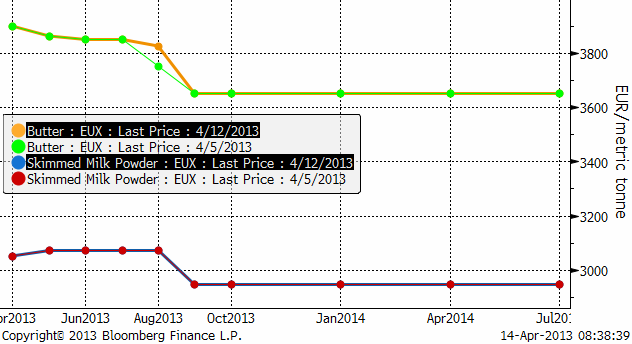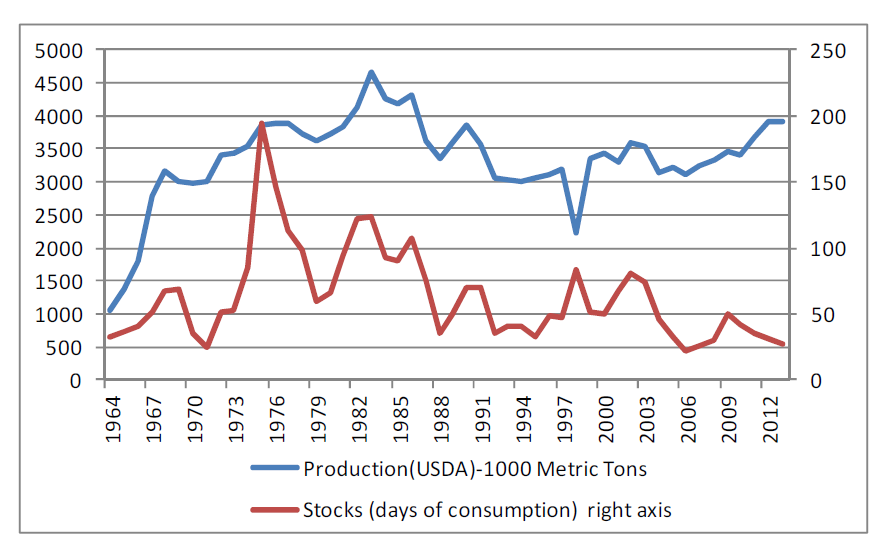Analys
SEB Jordbruksprodukter, 15 april 2013
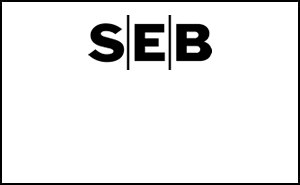
 Två tunga USDA-rapporter har kommit med tätt mellanrum. Lagerstatistiken fick vete, majs och sojabönor på fall. April månads WASDE-rapport fick däremot inte några stora effekter på marknaden. Marknaden tyckte nog att de förändringar som analytikerna på USDA gjorde låg inom felmarginalen. De största förändringarna gjordes för Kina.
Två tunga USDA-rapporter har kommit med tätt mellanrum. Lagerstatistiken fick vete, majs och sojabönor på fall. April månads WASDE-rapport fick däremot inte några stora effekter på marknaden. Marknaden tyckte nog att de förändringar som analytikerna på USDA gjorde låg inom felmarginalen. De största förändringarna gjordes för Kina.
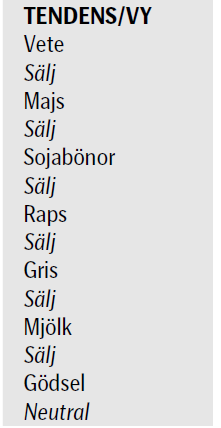 Det riktiga vilda västern hittar vi dock på den tidigare stillsamma mjölk-marknaden. Fonterras pris på skummjölkspulver har gått upp med nästan 100% sedan årsskiftet. Oroliga kinesiska föräldrar dammsuger världsmarknaden på mjölkersättningspulver. Till och med the Financial Times berättar om smugglingen av burkar till Kina. Livsmedelskedjor i Storbritannien har startat ransonering av den det åtråvärda pulvret. En kylig vy på detta vore kanske att sälja terminer på SMP för att säkra ett högt pris under det kommande året.
Det riktiga vilda västern hittar vi dock på den tidigare stillsamma mjölk-marknaden. Fonterras pris på skummjölkspulver har gått upp med nästan 100% sedan årsskiftet. Oroliga kinesiska föräldrar dammsuger världsmarknaden på mjölkersättningspulver. Till och med the Financial Times berättar om smugglingen av burkar till Kina. Livsmedelskedjor i Storbritannien har startat ransonering av den det åtråvärda pulvret. En kylig vy på detta vore kanske att sälja terminer på SMP för att säkra ett högt pris under det kommande året.
Odlingsväder
Det har regnat kring Mississippi-floden och temperaturen har varit kall. Det har bland annat förekommit rapporter om frostskador från USA. Vädret i Europa har slagit om till både varmare och fuktigare, vilket vi märkte av i helgen här i Sverige. Nedan ser vi senaste Drought Monitor för USA:
Vi ser att torkan har försvunnit nästan helt från östra halvan av USA. För USA som helhet är fortfarande 66% torrare än normalt eller torkdrabbat. Andelen av USA som är drabbat av de två mest extrema formerna av torka ligger kvar på strax under 20%.
Vete
Priset på november (2013) föll omedelbart från 220 euro ner till under 210 euro när lagerstatistiken publicerades av USDA för två veckor sedan. Efter att marknaden hade stirrat sig blind på lagerstatistiken hade man inte tänkt på att crop condition skulle rapporteras igen efter vinteruppehållet på annandag Påsk.
Sista mätningen före vintervilan låg på usla 33% och siffran kom därför föga förvånande in på 34%, uselt alltså. Det fick priset att stiga upp mot 215 igen. Förra veckan siffra var återigen en ökning av ”good/excellent” condition och det gav marknaden en anledning att sälja vetet. Så kom WASDE-rapporten i onsdags som marknaden inte gillade heller. Lagernivåerna ligger betydligt högre än förra månaden. Men med detta ur världen är det nu mer fråga om hur vädret ska utveckla sig de närmaste två-tre månaderna än något annat.
Decemberkontraktet på CBOT var nere och rörde vid 700 cent, som i all fall för närvarande kan betraktas som en bottennivå. Vi har i princip haft sidledes prisrörelse sedan början av mars och det finns ännu inte något som får mig att tro något annat.
Onsdagens WASDE-rapport är i princip oförändrad vad gäller produktionsestimaten. USDA sänkte inte Argentinas skörd, utan höll den kvar på 11 mt. På Argentinas Bolsa de Cereales hemsida kan man läsa att de tror på 9.8 mt och så har det varit ett tag. Man får väl anta att man har bättre koll på läget i Buenos Aires än i Washington, så vi ska nog räkna med lite lägre global produktion än vad USDA gör.
Om vi så ser till utgående lager nedan, höjdes de med 4 mt. Det beror dels på en höjning av EU:s utgående lager med drygt 1 mt, dels på lägre foderefterfrågan i USA och en uppskrivning av lagren i Kina med 3 mt. Det kan förstås hända att man har goda skäl till detta, men frågan är om ens kineserna har stenkoll på lagernivåerna i sitt stora land.
Siffran för utgående lager ligger 4 mt högre i aprilrapporten jämfört med förra månaden. Efter ett initialt prisfall fattade dock marknaden att USDA:s höjningar vilar på ganska osäker grund. En höjning av Kinas lager måste anses hugget som stucket och att man inte sänkte skörden minst 1 mt i Argentina talar egentligen mot bättre vetande (i Argentina). Det initiala prisfallet återhämtades alltså ganska omgående. Nedan ser vi lagernivåerna för varje april bakåt årsvis bakåt i tiden och priset i cent / bushel på Chicagovete. Vi ser att priset nu ser ut att ligga i linje med de senaste årens förhållande mellan lager och pris. Ju lägre lager desto högre pris, och vice versa. Rapporten gav alltså ingen riktning att handla på. Det talar fortsatt för ”sidledes” prisrörelse. Marknaden får ta input från väderutvecklingen för att hitta en riktning att handla på.
Terminskurvorna visar högre priser för gammal skörd den senaste veckan (fredag till fredag). De längre terminskontrakten har inte förändrats prismässigt alls.
Crop progress är en statistik att följa nu när lagerstatistiken och WASDE:n är avklarade. Måndagens Crop Progress från USDA visar på små förändringar gällande tillståndet för det amerikanska höstvetet, men det finns vissa tecken på en viss förbättring – även om de är små. 30% av grödorna klassas fortfarande som ”poor/very poor”, precis som i förra veckan, men 36% av grödorna klassas nu som ”good/excellent” jämfört med 34% veckan innan. Vid denna tid förra året var dock 61% klassat som ”good/excellent” och bara 10% klassat som ”poor/very poor”.
Grödornas tillstånd varierar kraftigt mellan olika regioner och stater. I Kalifornien klassas 95% som ”good/excellent” och andra stater med en hög andel höstvete klassat som ”good/excellent” är bl.a Illinois, Indiana, Missouri, North Carolina och Washington. Förutsättningarna är dock mindre gynnsamma i flera av de viktiga veteproducerande staterna. I Kansas klassas 31% av grödorna som ”good/excellent” medan 31% av dem klassas som ”poor/very poor”. I Oklahoma är fördelningen 28% / 33% medan endast 17% av grödorna i Texas klassas som ”good/excellent” medan 51% klassas som ”poor/very poor”.
Crop progress-rapporten som kommer på kvällen den 15 april förväntas även innehålla sådd av majs för första gången i år. Vi fortsätter tro på sidledes prisrörelse tills vidare. Vi har sett de högsta priserna för året – om det inte blir en rejäl torka i år igen. Allt annat lika bör man passa på att sälja på uppgångar tycker jag.
Maltkorn
Priset på maltkorn med leverans i november visade mer styrka än vetet för en månad sedan, men har planat ut och går nu som vetet, men avslutade veckan med att stiga med 4 euro samtidigt som vetet bara steg med 1.25 euro.
Majs
Majspriset (december 2013) har rekylerat ner mot 530 cent, där priset hittat stöd. Den senaste veckan har priset stigit till 550 cent och det gick fort. Lite som en studs på botten.
WASDE-rapporten från USDA visade 2 mt högre global produktion. Det beror på en höjning av Brasiliens skörd, till 74 mt från 72.5. Detta är dock fortfarande lägre än CONAB:s estimat som ligger 3.5 mt högre än USDA:s. Safrinha:n (andra skörden) har utvecklar sig enligt andra rapporter bra i Brasilien.
Globala utgående lager höjdes 8 mt från 117.48 mt av USDA. Av det ligger 3 i USA och 3 i Kina. I USA är det lägre foderefterfrågan men högre etanolefterfrågan. I Kina har vi ingen aning om vad det är som ligger bakom, egentligen. Vi kan notera att av ökningen i vete+majs-lager står Kina för en betydande del. Det är möjligt att detta är rimligt, med tanke på vilka effekter som fågelinfluensan kan få i framtiden för foderefterfrågan, men lager i Kina lär i vart fall inte komma ut på världsmarknaden om de skulle behövas.
Marknaden tog den här höjningen med en nypa salt, och handlade upp priset. Men från den här punkten är det vädret i USA (och på andra håll) som avgör. Vädret i Brasilien är bra och jag tror att CONAB:s prognos är mer rätt än USDA:s. Nedan ser vi lager och pris. Både lager och pris är som vi ser praktiskt taget på samma nivå som förra året.
Råoljepriset har fallit en tid och Brent-oljepriset har fallit ner till 103 dollar (från ca 110 – 115 för en månad sedan. Etanolpriset har däremot hållit sig, som vi ser i diagrammet nedan. Men det borde finnas en viss press på det – nedåt – från oljan.
Vi gör samma tolkning som i förra veckobrevet för två veckor sedan. Att vi har sett de högsta priserna och om vädret fortsätter att förbättras är det nedsida som gäller.
Sojabönor
Sojabönorna (november 2013) har fallit ner till 1231, strax ovanför ”nästa” tekniska stöd efter att den långvariga stödnivån på 1270-nivån bröts. Tekniskt ser det väldigt ”bearish” ut. 1150 ser ut att kunna vara nästa anhalt på vägen ner.
USDA justerade upp global skörd med drygt 1.5 mt – i Paraguay och Uruguay. Man lämnade skörden oförändrad i Argentina och Brasilien. Brasilien kan vi kommentera här: Conab (det nationella bolaget för matförsörjning) estimerar en skörd på 81.5 mt. Noticias Agricolas (ledande jordbrukstidning kopplad till jordbruksdepartementet) skrev den 8 april att skörden blir 82.5, 20% mer än förra året. Just nu är skörden till 80% klar enligt lokala tidningar.
Estimatet för utgående lager höjdes med drygt 2 mt. Höjningarna väntas ske i Argentina och Brasilien, vilket är rimligt att anta givet de mycket större skördarna där och köerna för lastning vid hamnarna (och lägre priser för lantbrukarna inne i landet pga detta). Kinas lager väntas minska och det beror på att man antagit att Kinas import minskar med 3 mt.
Nedan ser vi pris I förhållande till lager. Mot bakgrund av de senaste årens relation mellan pris och lager, ser priset ”högt” ut. Vid den här lagernivån ser ett pris på 1200 eller strax under det motiverat ut.
Vi tror att priset kommer att fortsätta falla och rekommenderar en såld position i sojabönor.
Raps
Rapspriset (november 2013) har rekylerat uppåt, vilket vi tror är ett säljtillfälle. I synnerhet om priset på sojabönor fortsätter att sjunka.
Gris
Grispriset (September 13) som tagit en paus i prisnedgången i drygt en månad, ser ut att kunna fortsätta sin nedgång i veckan som kommer.
Mjölk
Mjölkmarknaden befinner sig i mega-hausse. Fonterra-priset på SMP har fördubblats i år från 2500 till 4807 euro per ton. The Financial Times skrev i måndags förra veckan om hur flera engelska livsmedelskedjor endast tillåter kunder att köpa två burkar med mjölkersättning för spädbarn. Anledningen är att det uppstått brist därför att vissa personer köper burkar och skickar till Kina. Tidningen skriver att en vanlig burk som kanske kostar 60 – 90 kr i Sverige kan kosta tre gånger så mycket i Kina. Det sägs till och med att resorna till Australien från Kina har blivit fullbokade pga inköpen av mjölkersättning. Melaminskandalen häromåret och andra incidenter har fått kinesiska föräldrar att undvika inhemskt producerade produkter. Med ettbarnspolitiken finns tas inga risker av försiktiga föräldrar, tydligen.
I kursdiagrammet nedan ser vi priserna på Fonterras SMP, USDA:s prisnotering på SMP i Europa och Eurexbörsens pris, samt Eurex pris på smör. Alla priser är angivna i euro per ton.
Nedan ser vi terminskurvorna för smör och skummjölkspulver på Eurex.
USDA publicerar även statistik på mjölk och mjölkprodukter. I diagrammet nedan ser vi global produktion av
SMP sedan 1965 och estimerade utgående lager i termer av antal dagars konsumtion. Vi ser att globala lager av SMP är på riktigt låga nivåer i ett historiskt perspektiv. Lagren väntas räcka i 27 dagar. År 2006 var det 22 dagar och den lägsta lagernivån på 49 år. Detta är långt från de 81 dagars lager som fanns för 11 år sedan.
SEB Commodities erbjuder ett litet ”prova-på” kontrakt som består av 0.5 ton Eurex-smör och 0.9 ton Eurex SMP. Ett paket som motsvarar 10 ton flytande mjölkråvara. Just nu är det underliggande värdet på ett sådant kontrakt drygt 33 000 kronor.
Den som vill följa priset på SMP på Eurex gör det via länken:
www.eurexchange.com/exchange-en/products/com/agr/14016/
[box]SEB Veckobrev Jordbruksprodukter är producerat av SEB Merchant Banking och publiceras i samarbete och med tillstånd på Råvarumarknaden.se[/box]
Disclaimer
The information in this document has been compiled by SEB Merchant Banking, a division within Skandinaviska Enskilda Banken AB (publ) (“SEB”).
Opinions contained in this report represent the bank’s present opinion only and are subject to change without notice. All information contained in this report has been compiled in good faith from sources believed to be reliable. However, no representation or warranty, expressed or implied, is made with respect to the completeness or accuracy of its contents and the information is not to be relied upon as authoritative. Anyone considering taking actions based upon the content of this document is urged to base his or her investment decisions upon such investigations as he or she deems necessary. This document is being provided as information only, and no specific actions are being solicited as a result of it; to the extent permitted by law, no liability whatsoever is accepted for any direct or consequential loss arising from use of this document or its contents.
About SEB
SEB is a public company incorporated in Stockholm, Sweden, with limited liability. It is a participant at major Nordic and other European Regulated Markets and Multilateral Trading Facilities (as well as some non-European equivalent markets) for trading in financial instruments, such as markets operated by NASDAQ OMX, NYSE Euronext, London Stock Exchange, Deutsche Börse, Swiss Exchanges, Turquoise and Chi-X. SEB is authorized and regulated by Finansinspektionen in Sweden; it is authorized and subject to limited regulation by the Financial Services Authority for the conduct of designated investment business in the UK, and is subject to the provisions of relevant regulators in all other jurisdictions where SEB conducts operations. SEB Merchant Banking. All rights reserved.
Analys
A sharp weakening at the core of the oil market: The Dubai curve

Down to the lowest since early May. Brent crude has fallen sharply the latest four days. It closed at USD 64.11/b yesterday which is the lowest since early May. It is staging a 1.3% rebound this morning along with gains in both equities and industrial metals with an added touch of support from a softer USD on top.

What stands out the most to us this week is the collapse in the Dubai one to three months time-spread.
Dubai is medium sour crude. OPEC+ is in general medium sour crude production. Asian refineries are predominantly designed to process medium sour crude. So Dubai is the real measure of the balance between OPEC+ holding back or not versus Asian oil demand for consumption and stock building.
A sharp weakening of the front-end of the Dubai curve. The front-end of the Dubai crude curve has been holding out very solidly throughout this summer while the front-end of the Brent and WTI curves have been steadily softening. But the strength in the Dubai curve in our view was carrying the crude oil market in general. A source of strength in the crude oil market. The core of the strength.
The now finally sharp decline of the front-end of the Dubai crude curve is thus a strong shift. Weakness in the Dubai crude marker is weakness in the core of the oil market. The core which has helped to hold the oil market elevated.
Facts supports the weakening. Add in facts of Iraq lifting production from Kurdistan through Turkey. Saudi Arabia lifting production to 10 mb/d in September (normal production level) and lifting exports as well as domestic demand for oil for power for air con is fading along with summer heat. Add also in counter seasonal rise in US crude and product stocks last week. US oil stocks usually decline by 1.3 mb/week this time of year. Last week they instead rose 6.4 mb/week (+7.2 mb if including SPR). Total US commercial oil stocks are now only 2.1 mb below the 2015-19 seasonal average. US oil stocks normally decline from now to Christmas. If they instead continue to rise, then it will be strongly counter seasonal rise and will create a very strong bearish pressure on oil prices.
Will OPEC+ lift its voluntary quotas by zero, 137 kb/d, 500 kb/d or 1.5 mb/d? On Sunday of course OPEC+ will decide on how much to unwind of the remaining 1.5 mb/d of voluntary quotas for November. Will it be 137 kb/d yet again as for October? Will it be 500 kb/d as was talked about earlier this week? Or will it be a full unwind in one go of 1.5 mb/d? We think most likely now it will be at least 500 kb/d and possibly a full unwind. We discussed this in a not earlier this week: ”500 kb/d of voluntary quotas in October. But a full unwind of 1.5 mb/d”
The strength in the front-end of the Dubai curve held out through summer while Brent and WTI curve structures weakened steadily. That core strength helped to keep flat crude oil prices elevated close to the 70-line. Now also the Dubai curve has given in.
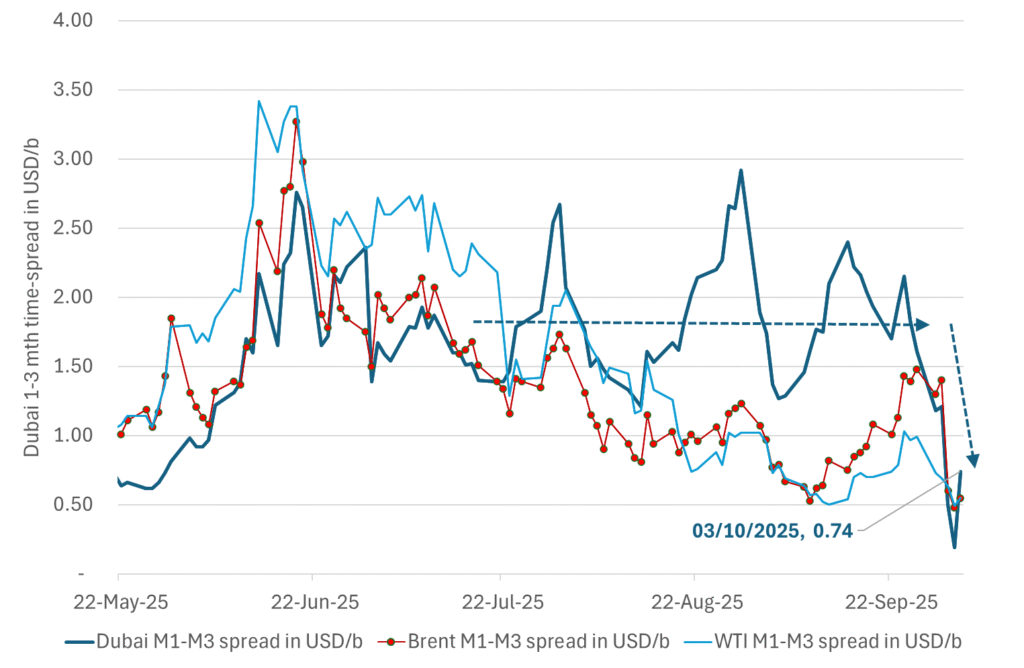
Brent crude oil forward curves

Total US commercial stocks now close to normal. Counter seasonal rise last week. Rest of year?
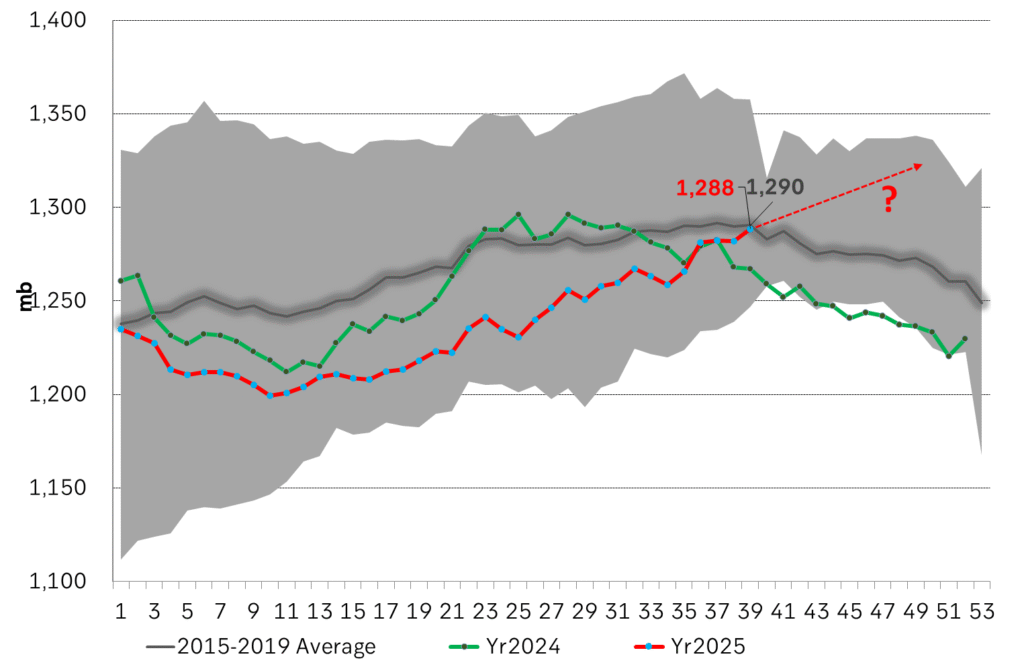
Total US crude and product stocks on a steady trend higher.
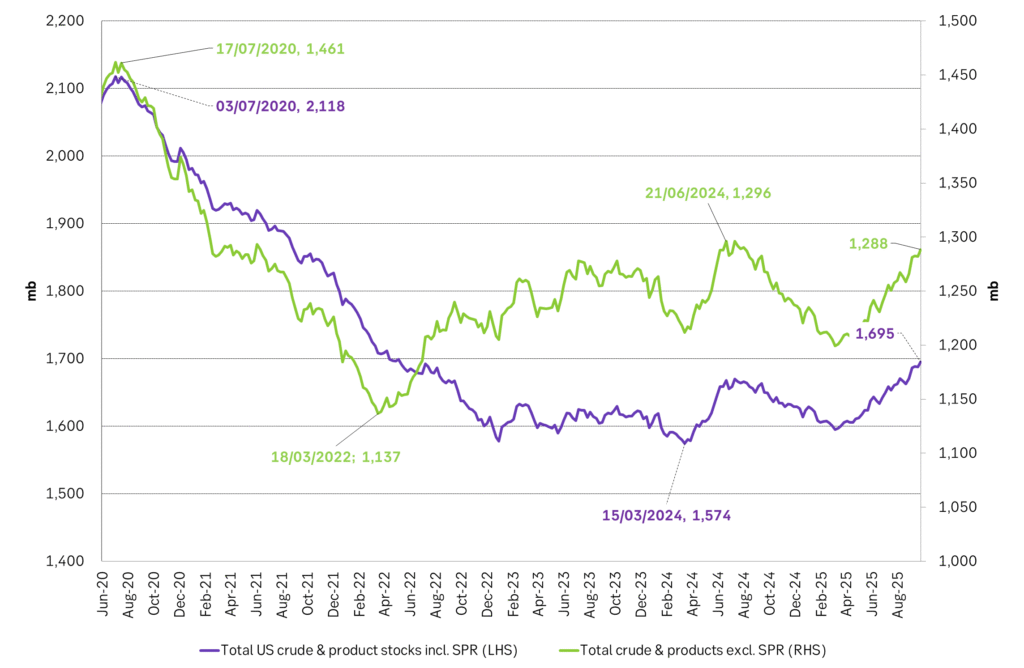
Analys
OPEC+ will likely unwind 500 kb/d of voluntary quotas in October. But a full unwind of 1.5 mb/d in one go could be in the cards

Down to mid-60ies as Iraq lifts production while Saudi may be tired of voluntary cut frugality. The Brent December contract dropped 1.6% yesterday to USD 66.03/b. This morning it is down another 0.3% to USD 65.8/b. The drop in the price came on the back of the combined news that Iraq has resumed 190 kb/d of production in Kurdistan with exports through Turkey while OPEC+ delegates send signals that the group will unwind the remaining 1.65 mb/d (less the 137 kb/d in October) of voluntary cuts at a pace of 500 kb/d per month pace.

Signals of accelerated unwind and Iraqi increase may be connected. Russia, Kazakhstan and Iraq were main offenders versus the voluntary quotas they had agreed to follow. Russia had a production ’debt’ (cumulative overproduction versus quota) of close to 90 mb in March this year while Kazakhstan had a ’debt’ of about 60 mb and the same for Iraq. This apparently made Saudi Arabia angry this spring. Why should Saudi Arabia hold back if the other voluntary cutters were just freeriding? Thus the sudden rapid unwinding of voluntary cuts. That is at least one angle of explanations for the accelerated unwinding.
If the offenders with production debts then refrained from lifting production as the voluntary cuts were rapidly unwinded, then they could ’pay back’ their ’debts’ as they would under-produce versus the new and steadily higher quotas.
Forget about Kazakhstan. Its production was just too far above the quotas with no hope that the country would hold back production due to cross-ownership of oil assets by international oil companies. But Russia and Iraq should be able to do it.
Iraqi cumulative overproduction versus quotas could reach 85-90 mb in October. Iraq has however steadily continued to overproduce by 3-5 mb per month. In July its new and gradually higher quota came close to equal with a cumulative overproduction of only 0.6 mb that month. In August again however its production had an overshoot of 100 kb/d or 3.1 mb for the month. Its cumulative production debt had then risen to close to 80 mb. We don’t know for September yet. But looking at October we now know that its production will likely average close to 4.5 mb/d due to the revival of 190 kb/d of production in Kurdistan. Its quota however will only be 4.24 mb/d. Its overproduction in October will thus likely be around 250 kb/d above its quota with its production debt rising another 7-8 mb to a total of close to 90 mb.
Again, why should Saudi Arabia be frugal while Iraq is freeriding. Better to get rid of the voluntary quotas as quickly as possible and then start all over with clean sheets.
Unwinding the remaining 1.513 mb/d in one go in October? If OPEC+ unwinds the remaining 1.513 mb/d of voluntary cuts in one big go in October, then Iraq’s quota will be around 4.4 mb/d for October versus its likely production of close to 4.5 mb/d for the coming month..
OPEC+ should thus unwind the remaining 1.513 mb/d (1.65 – 0.137 mb/d) in one go for October in order for the quota of Iraq to be able to keep track with Iraq’s actual production increase.
October 5 will show how it plays out. But a quota unwind of at least 500 kb/d for Oct seems likely. An overall increase of at least 500 kb/d in the voluntary quota for October looks likely. But it could be the whole 1.513 mb/d in one go. If the increase in the quota is ’only’ 500 kb/d then Iraqi cumulative production will still rise by 5.7 mb to a total of 85 mb in October.
Iraqi production debt versus quotas will likely rise by 5.7 mb in October if OPEC+ only lifts the overall quota by 500 kb/d in October. Here assuming historical production debt did not rise in September. That Iraq lifts its production by 190 kb/d in October to 4.47 mb/d (August level + 190 kb/d) and that OPEC+ unwinds 500 kb/d of the remining quotas in October when they decide on this on 5 October.
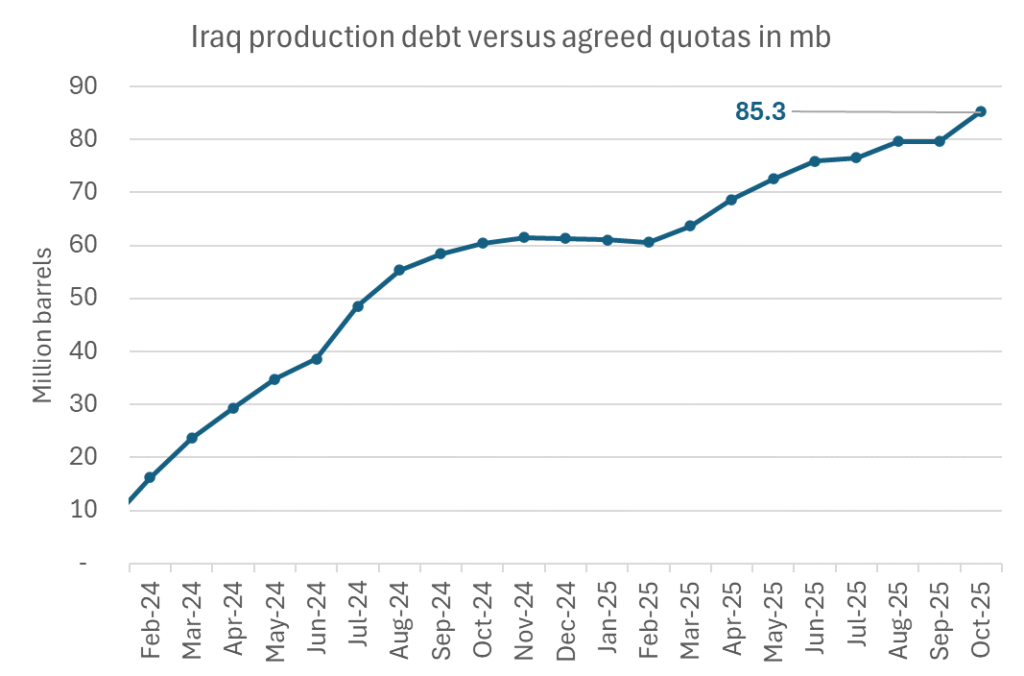
Analys
Modest draws, flat demand, and diesel back in focus

U.S. commercial crude inventories posted a marginal draw last week, falling by 0.6 million barrels to 414.8 million barrels. Inventories remain 4% below the five-year seasonal average, but the draw is far smaller than last week’s massive 9.3-million-barrel decline. Higher crude imports (+803,000 bl d WoW) and steady refinery runs (93% utilization) helped keep the crude balance relatively neutral.

Yet another drawdown indicates commercial crude inventories continue to trend below the 2015–2022 seasonal norm (~440 million barrels), though at 414.8 million barrels, levels are now almost exactly in line with both the 2023 and 2024 trajectory, suggesting stable YoY conditions (see page 3 attached).
Gasoline inventories dropped by 1.1 million barrels and are now 2% below the five-year average. The decline was broad-based, with both finished gasoline and blending components falling, indicating lower output and resilient end-user demand as we enter the shoulder season post-summer (see page 6 attached).
On the diesel side, distillate inventories declined by 1.7 million barrels, snapping a two-week streak of strong builds. At 125 million barrels, diesel inventories are once again 8% below the five-year average and trending near the low end of the historical range.
In total, commercial petroleum inventories (excl. SPR) slipped by 0.5 million barrels on the week to ish 1,281.5 million barrels. While essentially flat, this ends a two-week streak of meaningful builds, reflecting a return to a slightly tighter situation.
On the demand side, the DOE’s ‘products supplied’ metric (see page 6 attached), a proxy for implied consumption, softened slightly. Total demand for crude oil over the past four weeks averaged 20.5 million barrels per day, up just 0.9% YoY.
Summing up: This week’s report shows a re-tightening in diesel supply and modest draws across the board, while demand growth is beginning to flatten. Inventories remain structurally low, but the tone is less bullish than in recent weeks.
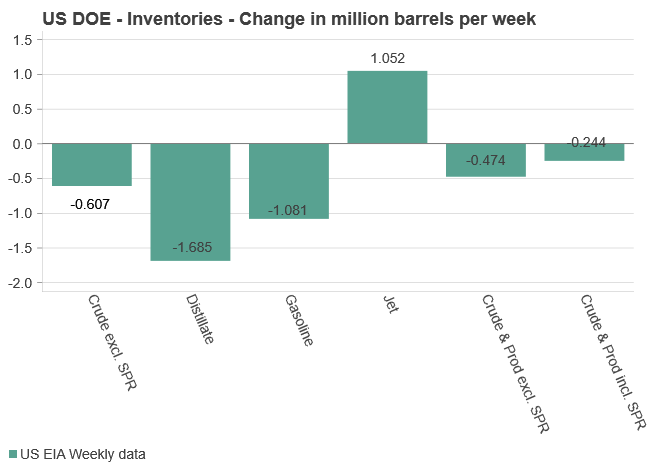
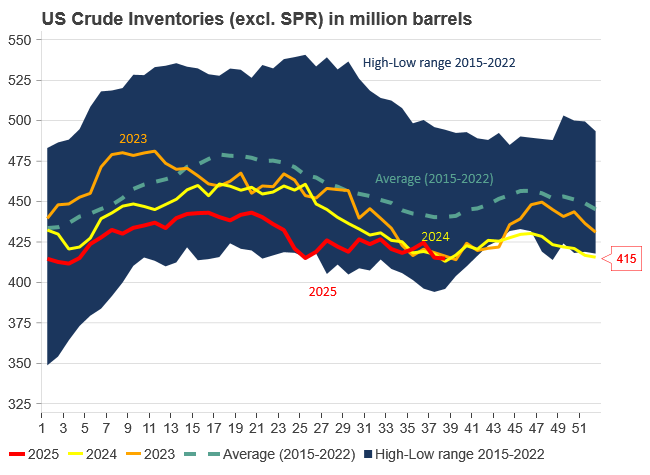
-

 Nyheter4 veckor sedan
Nyheter4 veckor sedanEurobattery Minerals satsar på kritiska metaller för Europas självförsörjning
-

 Nyheter3 veckor sedan
Nyheter3 veckor sedanMahvie Minerals i en guldtrend
-

 Nyheter4 veckor sedan
Nyheter4 veckor sedanGuldpriset kan närma sig 5000 USD om centralbankens oberoende skadas
-

 Nyheter4 veckor sedan
Nyheter4 veckor sedanOPEC signalerar att de inte bryr sig om oljepriset faller kommande månader
-

 Analys3 veckor sedan
Analys3 veckor sedanVolatile but going nowhere. Brent crude circles USD 66 as market weighs surplus vs risk
-
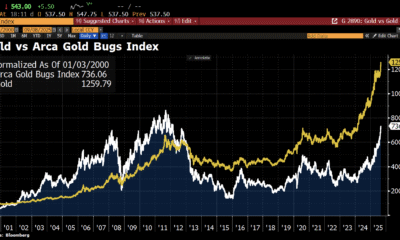
 Nyheter3 veckor sedan
Nyheter3 veckor sedanAktier i guldbolag laggar priset på guld
-

 Nyheter3 veckor sedan
Nyheter3 veckor sedanKinas elproduktion slog nytt rekord i augusti, vilket även kolkraft gjorde
-

 Nyheter2 veckor sedan
Nyheter2 veckor sedanTyskland har så höga elpriser att företag inte har råd att använda elektricitet


